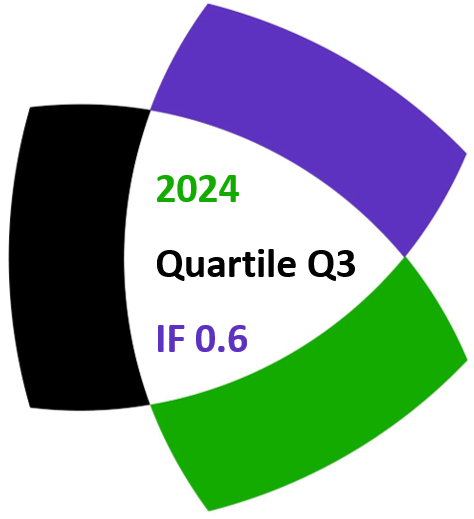Ranjit Biswas
Notes on Number Theory and Discrete Mathematics, ISSN 1310–5132
Volume 21, 2015, Number 3, Pages 1–21
Full paper (PDF, 2730 Kb)
Details
Authors and affiliations
Ranjit Biswas ![]()
Department Department of Computer Science
Jamia Hamdard University
Hamdard Nagar, New Delhi–110062, India
Abstract
This is sequel to our previous work [2,3,6] on region algebra. An important contribution in [2] is that the minimum platform required and being used so far by the world for practicing elementary algebra is unearthed and uniquely identified which is not group, ring, field, module, linear space, algebra over a field, associative algebra over a field, division algebra, or any existing algebraic system in general, but ‘Region Algebra’. The properties of region algebra are interesting as this is the minimal algebra which justifies free and fluent practice of elementary as well as higher algebra. This important identification was missing so far in any past literature of algebra or mathematics, and thus it is surely a unique algebra of absolute integrated nature. A new theory called by “Theory of Objects” and as a special case of it the classical “Theory of Numbers” were also studied in [2,6]. In this paper we say that every complete region A has its own ‘Theory of Numbers’ called by ‘Theory of A-numbers’, where the classical ‘Theory of Numbers’ is the ‘Theory of RR-numbers’ corresponding to the particular complete region RR. For the sake of presentation and to avoid any confusion we consider three theories here but finally we arrive at a unified unique theory at the end. The three theories designated in this paper are: Theory-1 (Theory of Numbers) which is exactly the existing “Theory of Numbers” in the literature (on real numbers and complex numbers); Theory-2 (Theory of Objects) which is about combinatorics on Region Algebra, about prime objects and composite objects, about a new ‘Theory of Numbers’ corresponding to every complete region (viz. the ‘Theory of A-numbers’ is corresponding to the complete region A, etc.); and Theory-3 (Theory of RR-numbers) which is all about the “Theory of RR-numbers”, a particular case of the “Theory of A-numbers” of Theory-2 where the region A is the complete region RR. In fact Theory-1 happens to be a special case of Theory-3, but initiating of Theory-3 done by the author is not with the purpose of ‘Making a generalization of the Theory-1’. It may also be noted that the Theory-3 is a special case of “Theory of A-numbers” where “Theory of A-numbers” is derived from the “Theory of Objects” of Theory-2. The “Theory of Objects” also induces a new field called by “Object Geometry” of a complete region, being a generalization of our rich classical geometry of the existing notion. It is claimed that the “Theory of Objects” will play a huge role to the Number Theorists in a new direction.
Keywords
- object
- region
- extended region
- calculus space
- complete region
- 2-to-1 bijection
- absolute partition
- positive object
- negative object
- bachelor
- conjugate bachelor
- exact division
- prime object
- composite object
- onteger
- unit length
- inverse unit length
- natural A-number (of a complete region A)
- RA value
- object line
- XA-axis
- YA-axis
- object plane
- object circle
- compound number
AMS Classification
- 97G40
- 97G99
- 11F23
- 11Gxx
- 14Pxx
- 14Qxx
References
- Artin, M. (1991) Algebra, Prentice Hall, New York.
- Biswas, R. (2012) Region Algebra, Theory of Objects & Theory of Numbers, International Journal of Algebra, 6(28), 1371–1417.
- Biswas, R. (2013) Calculus Space, International Journal of Algebra, 7(16), 791–801.
- Biswas, R. (2014) Introducing Soft Statistical Measures, The Journal of Fuzzy Mathematics, 22(4).
- Biswas, R. (2012) Fuzzy Numbers Redefined, Information, 15(4), 1369–1380.
- Biswas, R. (2014) Birth of Compound Numbers, Turkish Journal of Analysis and Number Theory, 2(6), 208–219.
- Biswas, R. (2012) Heterogeneous Data Structure “r-Atrain”, INFORMATION: An International Journal (Japan), 15(2), 879–902.
- Biswas, R. (2013) Theory of Solid Matrices & Solid Latrices, Introducing New Data Structures MA, MT: for Big Data, International Journal of Algebra, 7(16), 767–789.
- Copson, E. T. (1968) Metric Spaces, Cambridge University Press.
- Dixon, G. M. (2010) Division Algebras: Octonions Quaternions Complex Numbers and the Algebraic Design of Physics, Kluwer Academic Publishers, Dordrecht.
- Herstein, I. N. (2001) Topics in Algebra, Wiley Eastern Limited, New Delhi.
- Jacobson, N. (1985) Basic Algebra I, 2nd Ed., W. H. Freeman & Company Publishers, San Francisco.
- Jacobson, N. (1989) Basic Algebra II, 2nd Ed., W. H. Freeman & Company Publishers, San Francisco.
- Loney, S.L. (1975) The Elements of Coordinate Geometry Part-I, Macmillan Student Edition, Macmillan India Limited, Madras.
- Rudin, W. (2006) Real and Complex Analysis, McGraw Hills Education, India.
- Simmons, G.F. (1963) Introduction to Topology and Modern Analysis, McGraw Hill, New York.
- Van der Waerden, B. L. (1991) Algebra, Springer-Verlag, New York.
Related papers
Cite this paper
Biswas, R. (2015). “Theory of Numbers” of a complete region. Notes on Number Theory and Discrete Mathematics, 21(3), 1-21.


